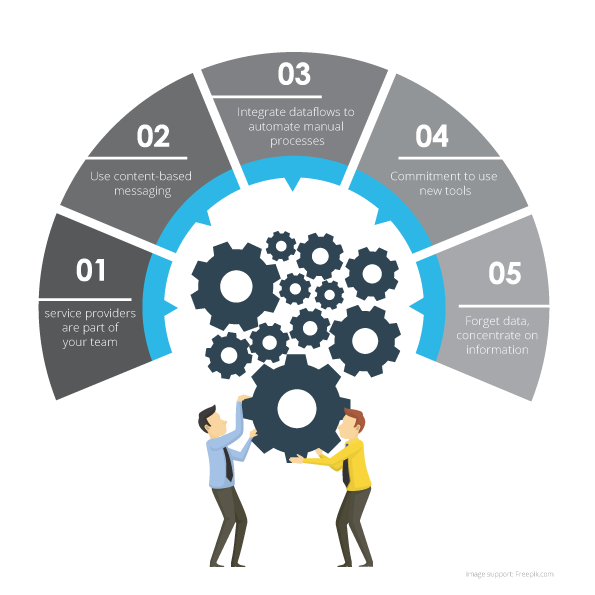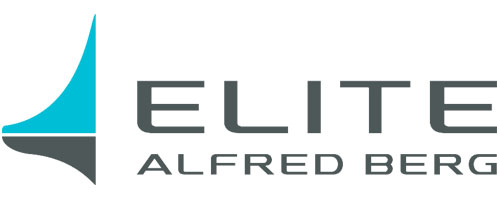We mentioned in one of our previous blogs that “Teamwork makes the dream work” and what it means to work as a team towards a common goal. But there are certain pitfalls on the way to success. In many cases it is the frustration about struggling with the same data related issues over and over again. Others are failing in communication due to a inconsistent data flow or even because of lacking the flow of data at all.
Data – an important asset
This blog is about consolidating, sourcing, and accessing your data. Data is one of the most important asset of any team. More importantly, data is an indicator of a team’s success. Teamwork is something every organization wants to support and improve; it is like the secret ingredient for running a successful business.
Let’s have a look at five things, making your teamwork successful.

1. Remember that service providers are part of your team
It is the most important aspect of teamwork and team communication: to have a software solution that is accessible for each team member, including also for example your service providers. The value of software that nobody uses is zero.
Your team is as big as you want it to be. Someone who is left out of the communications and an often forgotten member of the team are your service providers. When it comes to using your software solution, especially regarding how to use these correctly and in accordance to agreed-upon policies, this lack of communication can affect your team work much more then you might have thought.
Shared information frees your team from frustration, gives people a better understanding of the situation, a clear picture of required action, and builds motivation through transparency and responsiveness. If you and your service provider are working with the same tools, you will have faster responses and work done more proactively.
2. Content-based messaging
Who sent the email? What was the name of the file? When did I receive it? These are quite typical questions you hear in meetings when trying to find the materials you are searching for having a presentation or finalising a quarterly report.
Team communication tools are built for transparency and accessibility. But most of all, they are built to create a better flow of information. When providing better information flows, communication is an essential part of it. Interacting with the team is important because content increases productivity. When users can directly refer and access the information that they are messaging about, they are provided with a new sense of transparency, efficiency and, confidence in their work.
When your team is given a wide knowledge and transparency in communication, you will have happy and empowered people working for you.
3. Integrate your dataflows to automate manual processes
We are not recruiting monkeys to move data from place to another. When we are utilising fragmented files to share information, we forget about learning improved methods and instead fall into the old-fashioned process to consolidate and compile data.
When people file information in spreadsheets and send out the material via email, one crucial thing will be missing – the economy of scale; minimizing your costs through an improved and increased level of production. Utilising good communication tools that integrate with other systems saves time when your company reviews and analyzes the content. It will strengthen an organisation’s capacity to comprehend the content and, at the end of the day, development of the current processes.
Modern solutions offer open APIs to rapidly connect multiple systems. That helps you to enhance data flows and supports users creating information for other systems. Data from these applications become practical information through a combination of automated processes and supported interactions within your team.
4. Commit to using these tools
The data we have will not turn automatically into serviceable information, if we don’t physically sustain it. Often, employees get new tools for solving issues that will require some sort of interaction between people. These tools require people ́s commitment to collaboration and teamwork in oder to avoid low quality data.
If people are able to easily access and gather the necessary data, they are more likely to utilise those also and interact with it. And this is how your data turns into functional information.
Through new digital solutions, nurturing data becomes easier all the time. In today’s world, there are an unlimited amount of possibilities to digitalise asset management work and access real estate information anywhere or anytime. Teams and organisations across the business spectrum are changing the way they operate; many now conduct their work through remote working and easily available digital solutions. These changes can be seen in the real estate industry, but it is happening gradually.
So when selecting a new tool, work to make your team committed to the procurement process. Ensure that tools meet the required purposes for the teamwork and get the team excited about its possibilities.
5. Forget data and concentrate on information
Great teamwork is typically able to overcome issues when data is fragmented. However, too often people’s time is therefore used to collect and consolidate data. Focus and advantages are lost when the time is used for simple analysing and planning the next steps.
Property data usually means spreadsheets and it is easy to get lost in files and numbers. With modern asset management solutions, people are given the industry’s best tools with visualised content and ready-made concepts for collaboration and communication. When these are combined with the proper interaction with data, you end-up with refined, high-quality information that can be used for real decisions every day.
Focus on your people in the business
The ability to create an encouraging and inspiring working environment that fosters the teamwork, requires people, context, automation, tools, and commitment. This just happens to also be the magic combination that turns data into information. When you have a well-functioning team, it projects a positive image of the company through on-time and context-connected communication. It will also improve your customer service, sales and marketing; not to forget better reporting and processes.
Remember that the real estate business is “less about managing physical assets and more about empowering teams of executives, investors, accountants, controllers, property managers, asset managers, advisors and brokers to meet their targets.” Any dream team requires good conditions and well-working organisation to support them.
Many times PropTech companies talk about the data issue and data validation, but my agenda in PropTech is to bring people together and support their collaboration.
Author of this blog is Samuli Hiltunen, COO of Assetti Oy.








